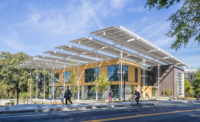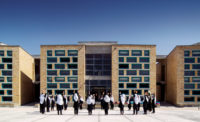On a clear day in Seattle—and, yes, there is such a thing—the view from a new 14,000-square-foot plaza to the west of the iconic Pike Place Market is so wide, you have to turn your head to take it all in: the derricks, shipping piers, warehouses, and giant Ferris wheel, bustling Elliott Bay, the islands of Puget Sound, and, in the northwest distance, the white-capped peaks of the Olympic Mountains. Perched on a hill rising steeply from the water, the plaza forms part of the Miller Hull Partnership’s mixed-use expansion of the 110-year-old market, a beloved institution that anchors a vibrant historic district. Completed last spring, MarketFront (as the project is called)—developed by a nonprofit, with the city providing the land and a grant covering about half the funding—forms a crucial node in reconnecting the urban core to its revitalizing waterfront.
Additional Content:
Jump to credits & specifications
The renaissance is being driven by James Corner Field Operations and the master plan the firm has developed for the city’s central waterfront, a 1¼-mile stretch from Pioneer Square to Belltown. The multiyear plan, now under way, calls for the removal of an elevated six-lane highway, the replacement of the seawall, and the creation or improvement of public spaces, multimodal streets, and new connections between central city neighborhoods and Elliott Bay. MarketFront is among the most significant of these new links. The project’s terraced civic spaces are united with a broad switchback promenade that will ultimately ramp down to the waterfront, stitching together part of the highway’s decades-long rip in Seattle’s urban fabric.
The challenge of the project—“the most daunting assignment I’ve had in 40-plus years,” says David Miller, founding partner at Seattle-based Miller Hull—was to find a formal and material language for the landmark site that would build on the market district’s historic character while creating a contemporary solution. Like many waterfront developments, the design for the 210,000-square-foot parcel (a former parking lot where a municipal market building burned down decades ago) evolved in a context of complex demands and intense public scrutiny.
MarketFront’s form and expression respond to the steepness of the site, key views and connections, local design guidelines, material cues from the streetscape, technical obstacles (including an active train tunnel running diagonally beneath the site), and extensive input from some 70—often heated—public meetings. The design addresses these diverse and complicated influences with an aesthetic that is immediately recognizable as Miller Hull’s: a rational, structurally expressive building, executed in simple materials, that sets up a mutually reinforcing relationship with its Pacific Northwest setting; the landscape—city, mountains, sea—is more comprehensible because the building is here, and the building only really makes sense in the context of the landscape.
In addition to its public spaces—the viewing plaza, wide seating steps, and multi-path promenade—MarketFront provides two levels of retail space and 40 units of low-income-seniors’ housing atop four levels of buried parking. For the commercial and civic components, a concrete-frame structure and board-formed concrete base elements are complemented with a heavy timber structure of glulams made from sustainably harvested lumber; the timbers are joined with steel connectors, and spanned with structural wooden decking. On the water-facing facades, expanses of aluminumframed glazing are backed with vertical timber stiffeners to resist heavy wind loads.
At the upper level, a pavilion consisting of a lightweight steel frame supporting a wood-soffited canopy is fronted with glazed garage doors that can be raised or lowered to shelter open-air vendor stalls while maintaining views from the original market behind. The pavilion provides a well-proportioned street edge for Western Avenue to the east, and helps to animate the viewing plaza on MarketFront’s western, waterfront side.
To the south, the tiered massing of senior housing forms a separate domain, while corrugated-steel cladding, aluminum-mullioned glazing, and tan-colored spandrels that pick up on the hues of the old market provide visual continuity with the rest of the complex.
If there’s a missed opportunity in the project, it’s the pedestrian bridge that spans Western Avenue between the original market and the new extension. A heritage designation protects the bridge’s mid-1980s enclosure designed by James Cutler, so instead of integrating it into MarketFront and highlighting its role as the first link in a magnificent new promenade, Miller Hull was able to do little more than add some doors in the facade facing MarketFront.
Even on a winter weekday morning, when no vendors are using the upper-level pavilion, a few visitors sit along its stepped edge or lean against the galvanized-steel guardrail of the plaza, enjoying the view. Boats beetle across the water. Behind, the city thrums. There’s a liveliness to the architecture itself, with its bold structure and tactile materials, and the planks of the platform’s wood decking give the expanse a comfortable scale. Suspended within the guardrail’s chain link panels, hundreds of small metal disks inscribed with donors’ names are flashing and winking in the sun, silently cheering, placeholders for the crowds that will enjoy Seattle’s newest civic space for generations to come.
CreditsArchitect: The Miller Hull Partnership, LLP, 71 Columbia St., Seattle, WA 98104, www.millerhull.com
Personnel in architect's firm who should receive special credit: Sian Roberts FAIA, Dave Miller FAIA, Brian Court AIA, Steve Doub AIA, Wojtek Szczerba AIA, Becky Roberts AIA.
Architect of record: The Miller Hull Partnership
Housing Developer: Beacon Development Group
Interior designer: The Miller Hull Partnership
Engineers Civil: Magnusson Klemencic Associates, (MKA) Structural: Magnusson Klemencic Associates, (MKA) Mechanical: ARUP Electrical: ARUP Plumbing: ARUP
Consultants Acoustical: Greenbusch Group Landscape: Berger Partnership Building Envelope: Wetherholt & Associates Lighting Design: dark|light design Door Hardware: Adams Consulting Services Elevator: Elevator Consulting Services ADA: Karen Braitmayer, FAIA Acoustical: Greenbusch Group Inc. Code: Tom Kinsman Geotechnical: Shannon & Wilson SEPA: EA Engineering, Science and Technology Archaeological: ESA Associates Land Use Attorney: Hillis, Clark, Martin, & Peterson Wayfinding: RMB Vivid Traffic: Heffron Transportation
General contractor: Sellen Construction
Photographer: Lara Swimmer Photography |
SpecificationsStructural System Manufacturer of any structural components unique to this project: Glue-laminated Framing: Bojarsky Inc.
Exterior Cladding Curtain wall: Kawneer Metal Panels: AEP Span Cement Panels: Swiss Pearl Precast concrete: Olympian Precast Moisture barrier: Tyvek Water repellent and anti-graffiti coatings: Evonik. Sealants: Dow Corning, Pecora Insulation: Knauf, Owens Corning, Thermafiber
Waterproofing Below-grade and protected membrane systems: Cetco
Roofing Multi-ply: Soprema Metal: AEP Span
Windows Vinyl frame: VPI
Glazing Glass: Guardian
Doors Automatic Sliding Entrances: Stanley Metal doors: Ceco Door Products Wood doors: Lynden Doors Fire-control doors: Crawford Security grilles: Cookson Sectional Doors: Wayne Dalton
Hardware Locksets: Sargent Closers: Norton Exit devices: Sargent
Interior Finishes Residential Cabinetwork: Custom Interiors Interior Paints: Rodda Paint Exterior Paints: Tnemec Solid surfacing: Basix Surfaces Floor and wall tile: Dal Tile Resilient flooring: Patcraft Carpet: Milliken
Lighting Interior: WAC Lighting, Lithonia, Eureka, Prudential Exterior: Bega, Lumascape, Wagner, Elliptipar, B-K, Bock, Vision 3, Hi-Lite Manufacturing, WE-EF Dimming system or other lighting controls: Eaton
Conveyance Elevators: Otis
Specialties Facility Chutes: Wilkinson Hi-Rise
Plumbing Residential Faucets: Delta Residential Sinks: Elkay, Kohler Residential Toilets: American Standard Residential Showers and Tubs: FiberFab
Energy Energy management or building automation system: Johnson Controls |










Post a comment to this article
Report Abusive Comment